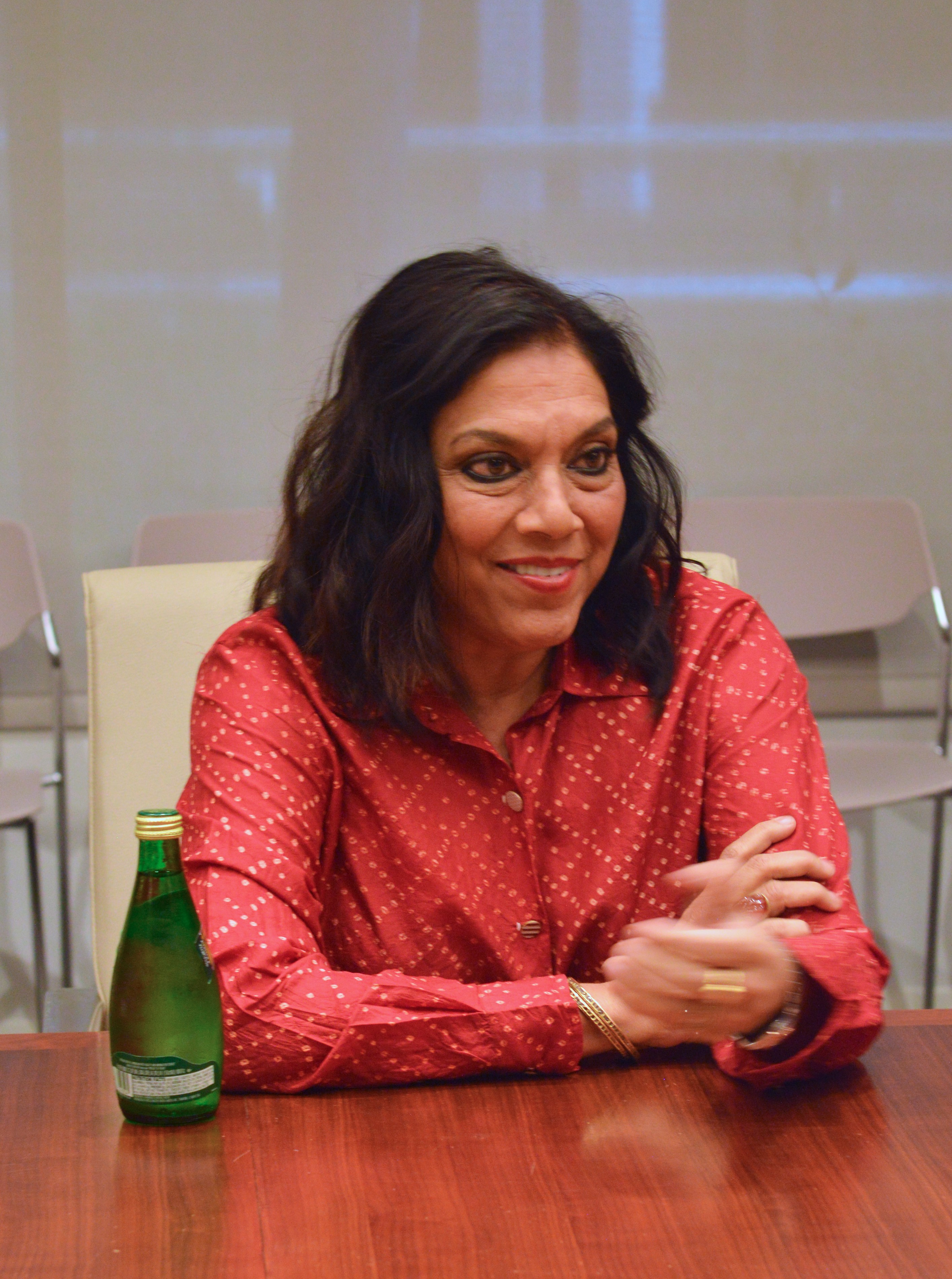
Sitting down and chatting with Queen Of Katwe Director Mira Nair was a remarkable experience. Her passion for filmmaking, her love for her country, and her long-time work as an activist was inspiring. She is an award-winning filmmaker who moves back and forth between Hollywood and independent cinema. After several years of making documentary films, Nair made her remarkable debut feature film “Salaam Bombay!” (1988). The film received more than 25 international awards including an Academy Award® nomination for Best Foreign Language Film. You may recognize her second film, “Mississippi Masala” (1991) starring Denzel Washington and Sarita Choudhury, which won three awards at Venice, a Best Feature nomination at the Independent Spirit Awards and introduced her to Uganda, where it was partially filmed and set and where she has since made her home.
Nair was full of smiles as she began our question and answer session on directing Queen Of Katwe, casting the movie, and giving back to the people of Uganda.
Can you tell us a little bit about how you got involved in the project?
Mira Nair : I’ve been living in Kampala now 27 years, ever since I made Mississippi Masala there and started my life there. I fell in love and had a son and planted gardens and created a film school called Maisha and the slogan of Maisha is if we don’t tell our own stories, no one else will.
Because there are so few images of African on any screen anywhere and when there are, it’s usually death, despair, dictators, bestiality. So we created the school, because we have to make the dignity and the joy of everyday life in our street in Kampala, anywhere. You know, be specific. Be local. Be truthful. And be excellent. It was such irony that despite my being surrounded by local stories for 12 years — we had 680 alumni students now, we have several directors we have created from East Africa — that this story of Phiona Mutesi, who lived 15 minutes from my home — I did not know about her.
I learned about her because a young man from this building, Tendo Nagenda, who’s a Ugandan and EVP of Queen of Katwe, Disney came to see me in my garden in Kampala when he was at a family reunion about four years ago. And he showed me this little article about Phiona in the ESPN journal, about this child who sold corn in Katwe who now was heading to becoming a chess prodigy and going to the Olympics in Russia. And I was completely struck by the story. I said I’d love to meet Phiona first. And I met her funnily enough in New York City where I lived the rest of the year. I lived half my time in Uganda and half the time in US. I met her there and with Robert Katende, and we had such a lovely connection instantly, because we are Ugandan and we were like, you know, joking, slanging, everything.
Then I got to know her really well and also Robert and then asked to meet Harriet and spent a lot of time with her. She took me just below where I lived is where she was evicted when her husband died. And she took me in the ramshackled van and we spent the day just going from one place to another where she had been with her four kids. At and abandoned church, the veranda of a little vendor stand, a shop somewhere, finally a little room. I mean like when I saw the trajectory of actually the struggle, the homelessness, the struggle and her fierceness to keep her family together against absolutely every odds there was, it just was so deeply moving and great because she was full of courage and full of pragmatism. She was not a defeated woman by any means, you know. To have a house at the end of it made by her daughter’s earnings, I mean [SIGHS].

Photo by Carol Jones/AllMommyWants.com
Special Connection to Harriet
Then there’s another story even though you haven’t asked I’ll tell you, because [LAUGHS] I have this school. I have a dinner for all the students who come once a year and I invited Harriet and Phiona and everyone that year. They came to my home and you forget when you live in a home with a garden you think people have seen a home with a garden, but not Harriet. She had never been in a place like that, a home and looking at my garden. I’m a real gardener. I have a nursery. I create my own plants. I create tree nurseries, everything. She looked at the garden very quietly and and she had got the new house by then and I said I would love to come and plant your garden. And she said — she just looked very quiet and she looked everywhere and she said it is because I have seen your garden that I will allow you to plant mine.
It was great, because she’s so dignified. The next day my pickup truck I put 80 plants and I drove out to her home and planted the garden over the course of a day. Someone gifted her a smartphone. And every time a flower blooms — that’s what I get [a photo from the phone], because she doesn’t speak English, she speaks Ugandan. She clicks the flower and she sends it to me.
I have this sort of love connection with Harriet which is without words but just to do with trees, ever since.
What challenges did you face bringing the story to life?
Mira Nair : The most beautiful challenge was to distill the love and familiarity I have with my own home, my adopted home of Uganda, the people, the sassiness, the vibrancy, the style. Kampala is the center of used clothing in the world to give you an example. Clothes come in by weight, and there’s that market called Owino where Lupita goes as Harriet to sell her mother’s outfit. That is the market. Everyone dresses from that. You see the style of like a Pucci dress with a kitenge wrap on her — you know, that’s how my fish seller gives me fish every second day. So, I wanted to capture that sort of emphasis of like no matter what we don’t have, we will put forward something that is excellent! So the great challenge was to capture that sense of what we call in slang in Kampala lifist, somebody who embraces life fully and doesn’t complain about what you don’t have. If you have half an inch of water, you will wash your hair, and no one will know that you had a struggle. This the quality of what I live around and this is the quality that I hoped to capture. And, of course, Phiona, in her real remarkably and utterly true story gives us so much of that.
The other thing I really wanted to capture is that you cannot do it alone. You have to have the fire in you, but it takes a village. It takes a teacher to see your talent. It takes a mother to shepherd you, whether it is a right shepherding or not, whether she has to argue and not understand that it is a gambling game, is it not gambling. She, she wants to protect her children from disappoint. There is no point, she says, to have dreams because you will be disappointed. But Phiona proves to her mother quietly and steadily that it is possible to — with a teacher like this, with a community like this, with a street like this, with a family like this, it is possible to achieve what you could dream for. And that is the beauty of life there. That is what I wanted to achieve. It’s not just one girl’s story, but what I call the prismatic story, the story of the whole street, the story of the family, the story of the mother and the complexity of every character.
The other sweet challenge was filming chess [CHUCKLES]. It’s really a challenge to film chess, because it’s a highly intellectual game. And it’s about strategizing and making moves, and how can I as a visual filmmaker, as a visualist, make chess interesting? Can I? These were really truthful games. They were real games, real moves that Phiona was famous for. It wasn’t a made-up situation. So, Sean Bobbitt, our cinematographer, and myself really looked at every game as a unique visual challenge. We filmed every game differently from the other. And that was a challenge, because there’s only so many things you can do with the chess board. But how to create chess so that it can be emotional, dramatic, and propulsive, propel the story forward, and yet not bore you to death! Also satisfying the chess afficiandos. That was a, that was a sweet challenge.
So now did you play chess before, or did you have to learn the game a little?
Mira Nair : I was the mother of a competitive chess player. My son played competitive chess when he was eight, and we would go to Parsippany and go Holiday Inn in Atlanta. I was at all kinds of places. So I was part of the chess circle, but I didn’t really know chess well. I understood it, but I didn’t really play it. The real Phiona, taught me chess prior to the shooting. She would just laugh at me, because I was reckless and I would move the piece and she would say, ahhh, Mira, you must consider the other side of the board. [LAUGHS] I said that’s a great line, Phiona. It’s like a metaphor for the world. If we all considered the other side of the world it would make life work. I used to write down what she would say, it comes out of her mouth in the movie if you notice it.
She would say are you, are you focusing on the game or on your film? I said the film. [LAUGHS] I love that as a teacher, she was fantastic.
How was it working with the costume designer?
Mira Nair : Kitenge, you have to love Uganda. That is how people are. I said before, the vibrancy of the style is something I have loved as I lived there, it’s about really having a sense of smartness. I used to have a great nanny, she is like my younger sister. She really helped me raise my son. When he was a little boy, every time we would go on a plane she would want him to put him in a three-piece suit. [LAUGHS] I would say, please let the track pants stay on. Let him be comfortable. We worked with a great costume designer, Mobolaji Dawodu, he’s Nigerian-American. He made this ravishing film called Mother of George. I had seen his work and it was about a Nigerian family in Brooklyn. And the way he shot and styled the African clothing, kitenge is what it’s called, vividly patterned fabric. It’s this juxtaposition. My fish seller was wearing a genuine Pucci dress with the kitenge wrap on it. This is how it is there, because all our clothing, the costumes in our film, all came from Owino, the actual second-hand market. We really did not need a big budget for this.
Even though everyone is dressed very vividly, it is actually how people are. And we went into the second-hand markets for all of it.
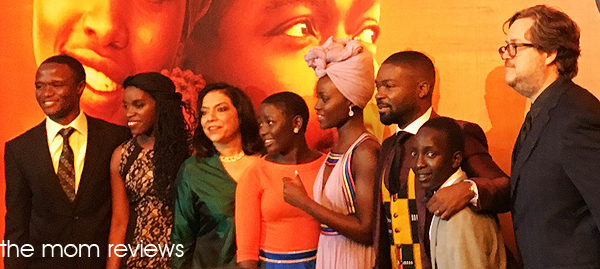 Can you talk about casting?
Can you talk about casting?
Mira Nair : If you know my work from Salaam Bombay, I always work a lot with non-actors, people who have never faced the camera before, opposite legends like Denzel Washington in this case Lupita and David. That kind of alchemy between the sort of purity and lack of artifice of a child actor, of a child really, not even an actor –opposite a legend who has a lot of tricks to their trade and all those tricks kinda have to drop off when you’re faced with the purity and freshness of a kid. Especially a kid who comes from the same streets as the story that you’re filming. For me it was always critical that we don’t go too far afield to find our children. All our kids came from Katwe or Chibuli, which is the neighboring community right across the street from Katwe. All our kids have come from there, do live there.
For Phiona, I saw 700 girls mostly in Uganda but also in Kampala, in Kenya and in England. But I was sure that we would find her in Uganda, it was tough because this is the role that carries the whole film. One girl plays the Kenya champion. She was the finalist of Phiona. But to be honest, I was not in love. I was not in love and I only trust love. I trust my instinct. I have to love you, because I have to live with you for years, forever, exactly. You cannot have hesitation on casting, you know. So in January, six months after seeing so many girls, my very close friend and casting director, Dinaz Stafford was led to Chibuli, to a little dance company called Sosolya Dance Company where young kids learn traditionally dancing and performing in hotels on Sunday nights. They went into this rehearsal and they filmed Madina sweating and smiling. Then they came to dinner, they came home he said Mama, I have another possible Phiona. I just kinda rolled my eyes and thought, oh, my God, seven hundred and first [LAUGHS] aghhh. They showed me the film, and she was magnetic, but I still put her through the ringer for like three weeks of testing and learning to play chess.
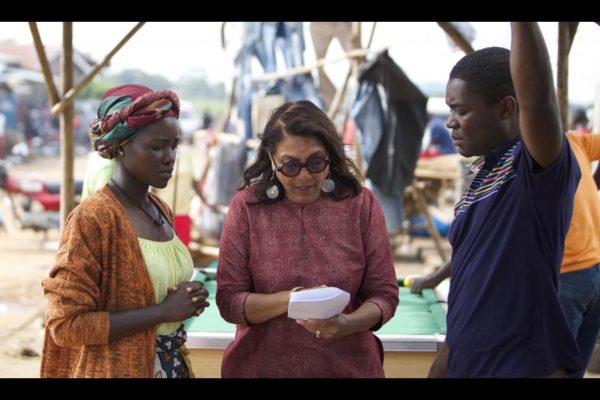 Even though English is spoken in Uganda, Luganda is the mother tongue. Can she think in English? Can she emote in English? But the thing is she was a dancer and she was a great dancer. So, since the age of four, she has had an extremely similar life to Phiona where chess was Phiona’s way out. Dance is Madina’s way. But dance has given her this great balletic grace over her body and a control over her body, which is a very beautiful thing to have as a film actor, because you have to go for a kind of stillness sometimes, and I found the physicality very beautiful. She owned it and she’s extraordinary. The other children were cast similarly. A lot of kids — actually four kids came from that dance company. A lot of the boys came from there too. Brian, who plays her brother was in a football club, lives literally outside the gates where I live. There was a football local club and his coach brought Brian in, and I just loved his performance, his sense of comedy.
Even though English is spoken in Uganda, Luganda is the mother tongue. Can she think in English? Can she emote in English? But the thing is she was a dancer and she was a great dancer. So, since the age of four, she has had an extremely similar life to Phiona where chess was Phiona’s way out. Dance is Madina’s way. But dance has given her this great balletic grace over her body and a control over her body, which is a very beautiful thing to have as a film actor, because you have to go for a kind of stillness sometimes, and I found the physicality very beautiful. She owned it and she’s extraordinary. The other children were cast similarly. A lot of kids — actually four kids came from that dance company. A lot of the boys came from there too. Brian, who plays her brother was in a football club, lives literally outside the gates where I live. There was a football local club and his coach brought Brian in, and I just loved his performance, his sense of comedy.
All the kids were either open casting calls on the streets and in the national theater. All the kids are from that area. Then it was two months of workshops, dance and debate and, all kinds of ways. I kept seeing who does what interestingly. Like Benjamin, who has the lollipop and I just loved it. You know, they make a lot of great sounds, like ahhh eeeeeh iiiish. [LAUGHS] It’s like this. You know, we talk like this. Benjamin [CHUCKLES] was constantly ahhhhh ahh. And I used it all the time. Or that snap, it’s such a lifist example. I would say snap now, Benjamin snap now. I liked it. It was like checkmate! One time somebody even tapped me and said, Mira, I think you’re going for too many snaps [LAUGHS] I said, no you wait, it will be the catchiest thing. ‘Cause I’m a shameless populist. I like to put bombs on seats. I like to entertain you. This is the spirit of our people. People ask can you do it? I can’t do it.
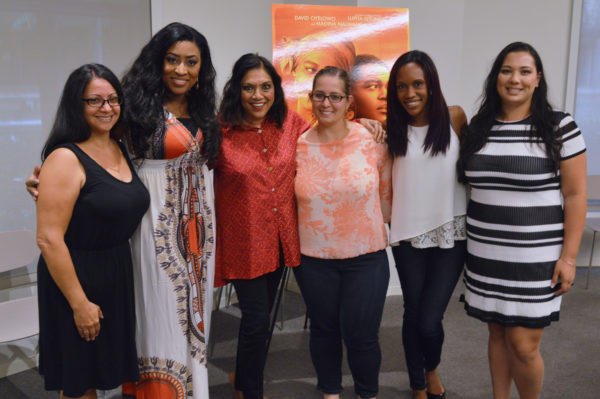
How has the shooting of the film impacted the people of Queen of Katwe and Kampala?
Mira Nair : Well we were waiting with our eyes for sure. One is because it is my home. That is where I live. I’m not gonna run away. So we have been doing several things. One is we ran a green set, an ecological set, which is unheard of there, because plastic is so awful. We turned everything into a recycled sort of heaven. We also worked with the community of Katwe. We called it the Legacy Project while we were shooting, which is all shot in Katwe and the real places. We asked what the community needed and it was decided with the elders of the community that toilets, public toilets were the big thing. We have a project with Disney to build a whole series of public toilets in Katwe, just a small example.
But then recently they had just purchased land and a building in Katwe to house permanently the Chess Academy. Then we have an educational fund for all the pioneers in the film to go to university is the idea. That’s a very complicated and very excellent endeavor. Like in the film, like in life, education isthe cornerstone. And in Kampala, it’s a big emphasis. People knock on your door every day for school fees because whatever it is you must go to school. The education of our kids is vital. Lastly in our film school, Maisha, which is now become a community interdisciplinary school for the community, we are building the last phase of the physical school, hopefully with Disney’s help, which creates a open-air community theater and audio visual library, because that is what is not there. I mean there is no libraries. There are no books. That is what I’m appealing for. Because it is impossible for us to have done this thing and made this film and not care about what happens in the future, because the whole film is as much as it is about the present, it is about the future of our kids.
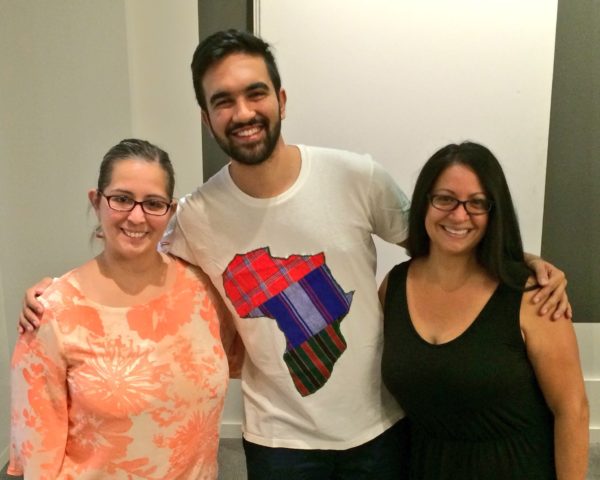
#1 Spice
We also were treated to a visit from a special guest! Young Cardamom (Zohran) is Mira Nair’s son and one half of the duo Young Cardamom & HAB whose hit song #1 Spice is the catchiest tune in the movie! Watch the clip below and buy it on iTunes, you know you want to!
Queen Of Katwe is in theaters everywhere September 30, and for more #QueenOfKatweEvent posts, interviews, and red carpet experiences from our trip, check out the following link, http://jenisonajourney.com/tag/queen-of-katwe.
Like QUEEN OF KATWE on Facebook: Facebook.com/QueenOfKatwe/
Follow QUEEN OF KATWE on Twitter: @queenofkatwe #QueenOfKatwe #QueenOfKatweEvent
My trip that included this interview with Mira Nair was hosted by Disney but every opinion documented is 100% my own.



Leave a Reply